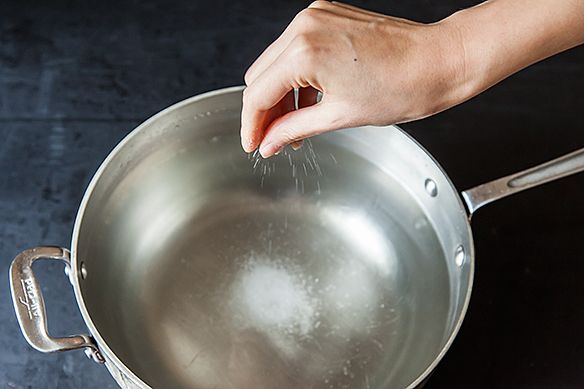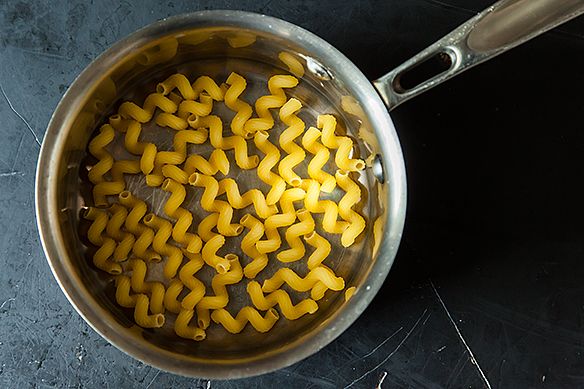Popular on Food52
26 Comments
julianne
June 15, 2014
wow, I was devastated when marie callender's (conagrafoods) discontinued their 4 minute meal bags but now it's looking a bit brighter, would everybody please help me flood the conagra website with complaints about the discontinuation, I am sure I am not the only disabled one who depended on this quick and delicious meal.
Eva
February 14, 2014
Ever since hearing Harold McGee's description of his cooking method on NPR, I've been a convert. My mom, too. We never cook pasta in giant vats of boiling water anymore. The cold-start/skillet method uses less water, cooks the pasta more slowly (so you have greater control over the resulting texture), and creates a more concentrated "pasta water", as the article states.
Plus no one seems convinced it'll work the first time you show them. Great "party trick".
Plus no one seems convinced it'll work the first time you show them. Great "party trick".
SBMCW
May 3, 2013
That absolutely works. Harold McGee, who wrote "Of Food and Cooking", is in the video. His book has attained cult status in the culinary industry. Very interesting book and a deep dive into the Mister Wizard world of cooking.
Lan P.
May 2, 2013
I've recently seen another way of cooking pasta over at CHOW channel here - http://www.youtube.com/watch?v=Zkz4ef53YjA Pasta straight from frying pan, what you think of this?
SBMCW
November 30, 2012
Method #3 might be best in a small New York kitchen in the summer with no air conditioning. You can also use the boiling water to make the pasta just pliable and put the pasta into a very loose sauce and finish cooking on the stove. I also use tongs to remove the pasta to ensure I have pasta water to adjust the sauce. If you have friends that are always late using tongs allows you to cook pasta for the punctual guests and save the water at a simmer to cook pasta for the late comers quickly.
Cinnamin
September 13, 2012
Wow- the 60 second method is pretty cool! I am a classic girl so far, should try these alternatives out
Lost_in_NYC
September 5, 2012
Whats the purpose of method #3? 1.5 hrs (method #3) vs 8-9 minutes the traditional way. I think its a no-brainer. The 60 seconds doesn't really have an appeal honestly.
Kristy M.
September 5, 2012
I think the 60-second method is fun and exciting! Sometimes you just want to have fun in the kitchen.
Genius R.
September 5, 2012
In their book, Alex and Aki explain that having pasta ready within moments can be useful in larger scale cooking operations for a la minute cooking, but also for busy families who can keep a container of soaked pasta on hand all through the week for super quick meals. (Speaking of fun in the kitchen, they also play with the soaking water to infuse flavors into the noodles, notably with barbecue sauce.)
walkie74
September 6, 2012
So you don't have to soak it for exactly an hour and a half? You could start it, say, that morning before you go to work. and then cook it that night? And could you soak it, drain it and store it? Wow, if you can do both, I would *totally* try this...
walkie74
September 6, 2012
So you don't have to soak it for exactly an hour and a half? You could start it, say, that morning before you go to work. and then cook it that night? And could you soak it, drain it and store it? Wow, if you can do both, I would *totally* try this...
Hurri C.
September 4, 2012
For any type of pasta other than spaghetti/fettuccine/etc., I usually use my pressure cooker. First, lightly toast the pasta in the pressure cooker over high heat with just a little bit of oil, then pour in water (or a 50/50 chicken stock/water mix) until it's just touching the top of the pasta, add some salt (unless chicken stock was very salty), and then put the lid on. Once it comes up to pressure, lower the heat (as you normally do when using a pressure cooker!) and cook for 40% of the recommended cook time for that pasta, then release the pressure. At this point you could strain it and add to a saucepan with some sauce, but depending on the shape of the pasta there may not be much water left; sometimes I just put the heat back on and grate in pecorino until the water is all absorbed/evaporated.
MamaAl
September 4, 2012
Why do people boil pasta? Family secret: Bring water to boil then put in 1 tsp to 1 tbls of salt. Add pasta of chioce and stir until water starts to boil, turn to low and put on lid. Let sit for 5 to 10 min. , or until pasta is aldente. Size and thickness of pasta dictates how long pasta will sit.
fiveandspice
September 4, 2012
Simmering pasta?! I've got to try that. Method #5: Cook the pasta totally risotto style, adding it to sauteed onions, throwing in a splash of wine, then adding a couple ladlefuls of broth at a time and stirring until each addition is evaporated and continuing until the pasta reaches the texture you want.
Panfusine
September 5, 2012
The risotto style is the preferred method for making 'semiya upma' a traditional South Indian breakfast.. (I have no clue when & how the capellini pasta got into the traditional South Indian Pantry, but it even got its own name 'Semiya')
the pasta is toasted golden and then added into a seasoned broth and cooked down
http://wholefoodsmarketcooking.com/recipes/11023_stellini_upma_with_roasted_cauliflower_couscous
the pasta is toasted golden and then added into a seasoned broth and cooked down
http://wholefoodsmarketcooking.com/recipes/11023_stellini_upma_with_roasted_cauliflower_couscous
LucyS
September 5, 2012
I tried this once! I used white wine and chicken stock. The result was SUPER rich and it took ages - but delicious.
Eva
February 14, 2014
Yes, this is often the best way to make the dish 'pasta in brodo' (pasta in broth). You can do it with water, but it's even better with stock/broth. Method #4 (just below) is another way, but I think the "risotto method" creates a nicer result because it seems to draw out more of the pasta starch over the longer cooking time and create a more luxurious "sauce". A bit of grated parmiggiano over the top is fab.
chairmanhu
September 4, 2012
Method #4: Cook the pasta in a large saucepan with chicken stock, covered. When halfway done, uncover and stir while the stock reduces and evaporates. Melt in some butter, garlic, parsley and a squeeze of lemon. All sorts of leftovers work with this for a quick midweek dinner.
It's tricky to get just right to al dente, but it's a great way to plan a one pot meal, especially if you first cook up some vegetables and or meats beforehand in the same pot. Scrape up the brown bits with the stock :)
It's tricky to get just right to al dente, but it's a great way to plan a one pot meal, especially if you first cook up some vegetables and or meats beforehand in the same pot. Scrape up the brown bits with the stock :)





See what other Food52 readers are saying.